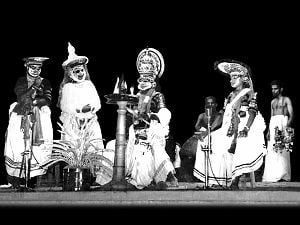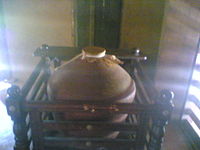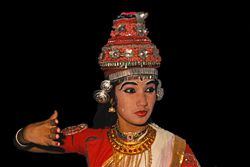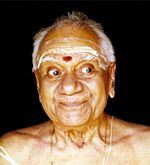Koodiyattam
{{#invoke:Message box|ambox}}

Koodiyattam or Kutiyattam (pronounced [kuːʈijaːʈːam]) is a form of theatre traditionally performed in the state of Kerala, India. Performed in the Sanskrit language in Hindu temples, it is believed to be at least two thousand years old. It is officially recognised by UNESCO as a Masterpiece of the Oral and Intangible Heritage of Humanity.
Template:TOC-left
Origin
Kulasekhara Varma Cheraman Perumal, an ancient king of Kerala, is known as the reformer of Koodiyattam in its present form, and his Aattaprakaram (actor's manual) is considered the most authoritative publication on the art form.
Instruments used
Traditionally, the main musical instrument used in Koodiyattam is the Mizhavu, a percussion instrument which is played by a person of the Ambalavasi Nambiar caste, accompanied by Nangyaramma playing the kuzhithalam (a type of cymbal). However, recently the Edakka, another traditional drum, has also been used as accompaniment.
Performance style
Traditionally, Koodiyattam has been performed by Chakyars (a subcaste of Kerala Hindus) and by Nangyaramma (women of the Ambalavasi Nambiar caste). The name Koodiyattam (meaning "playing together") suggests a combined performance of Chakyar and Nangyar. The main actor is a Chakyar who performs the ritualistic Koothu and Koodiyattam inside the temple or in the Koothambalam. Chakyar women, Illotammas, are not allowed to participate. Instead, the female roles are played by Nangyaramma.
The practice was that elders of the Chakyar community tought it to the youngsters of that community and it was an artform performed only by Chakyars till the 1950s. In 1955 Guru Mani Madhava Chakyar performed Kutiyattam outside the temple for the first time.[1] For performing the art forms outside the temples he faced lot of problems from the hardline Chakyar community. In his own words
"My own people condemned my action (performing Koothu and Kutiyattam outside the precincts of the temples), Once, after I had given performances at Vaikkom, they even thought about excommunicating me. I desired that this art should survive the test of time. That was precisely why I ventured outside the temple"[2]
In 1962, under the leadership of Dr. V. Raghavan- noted art and Sanskrit scholar; Sanskrit Ranga of Madras, invited Guru Mani Madhava Chakyar to perform Kutiyattam in Chennai. Thus for the first time in the history Kutiyattam was performed outside Kerala.[3] [4]They presented at Madras on three nights, Kutiyattam scenes from three plays Abhiṣeka, Subhadrādhanañjaya and Nāgānda.[5]
The performance of the maestro Maani Maadhava Chakyar made great impact on the people and art critics so that, Kutiyattam and Mani Madhava Chakyar became famous outside Kerala also. People outside Kerala was able to witness the extraordinary talent of the maestro.[6] Then Mani Madhava Chakyar was invited and performed Kutiyattam at various places of North India like New Delhi and Banaras (1964). It made the critic to accept his authority in Rasa Abhinaya, Natyasastra and Kutiyattam.
After Mani Madhava Chakyar's first tour to New Delhi, he was awarded immediately with Sangeet Natak Akademi Award in 1964 for his contributions to Chakyar Koothu and Kutiyattam, which became the first national recognition to the maestro and the art form. His supremacy in Rasa-abhinaya and Netrabhinaya and Kutiyattam became very famous and attracted lot of people towards the art form.
He performed Kudiyattam all over India and popularized the same. He along with his troop did Koodiyattam performance in places like Madras (1962, 1973 & 1977), Madhura (1962), New Delhi (1964, 1966, 1974, 1979 & 1983), Varanasi (1964 & 1979), Bombay (1973), Ujjain (1982), Bhopal (1987) etc.
The President of India, scholar and philosopher, Sarvepalli Radhakrishnan invited him to perform Kutiyattam at Rashtrapati Bhavan (presidential palace) in 1964 and was impressed by the Guru's exceptional acting skill. His Kutiyattam performances, lectures and demonstrations at well known centres like Madras Music Academy in Chennai, International Centre for Kathakali in New Delhi, Experimental theatre in New Delhi and Bombay, National Centre for the Performing Arts in Bombay fetched wide popularity and recognition for his Abhinaya and Kutiyattam.
He choreographed and directed acts of the plays like Kalidasa's Abhijñānaśākuntala, Vikramorvaśīya and Mālavikāgnimitra ; Bhasa's Swapnavāsavadatta[7] and Pancharātra; Harsha's Nagananda for the first time in the history of Koodiyattam. He along with his troupe performed these Kutiyattams all over India.[8]
He performed Chakyar Koothu and Koodiyattam for All India Radio and Doordarshan for the first time, which helped to attract thousands of listeners to these traditional art forms. It was he who started demonstrations in Kudiyattam to popularise the same.
In early 1960s Maria Christoffer Byrski- a polish student doing research in Indian theatres at Banaras Hindu University came to study Koodiyattam from the maestro Mani Madhava Chakyar and became the first non- Chakyar/nambiar to learn the art form. He stayed in Guru's home at Killikkurussimangalam and studied the art form in traditional Gurukula way.
Famous artists
In the modern world, the late Natyacharya Vidushakaratnam Padma Shree Guru Mani Madhava Chakyar has been the best-known face of Koodiyattam. He was known for mastery of Rasa Abhinaya with special reference to Netrābhinaya. He has been a major force in popularizing Koodiyattam by taking it out of the Hindu temples, performing across India with his troupe, and teaching it to non-Chakyar caste members. He has also adapted, choreographed and directed well-known plays such as Kalidasa's The Recognition of Sakuntala, Vikramorvaśīya and Mālavikāgnimitra; Bhasa's Swapnavāsadatta and Pancharātra for performance in the Koodiyattam style.[9]
Mani Madhava Chakkiar's disciple and nephew Mani Damodara Chakyar is also a renowned Koodiyattam performer, who is an exponent of traditional devotional Koodiyattams, such as Anguliyanka, Mattavilasa Prahasana, Mantranka, Ezhamanka (seventh act of Ascharyachoodamani).
Guru P.K. Narayanan Nambiar, son of Guru Mani Madhava Chakkiar was a member of Kutiyattam faculty of Kalamandalam. He is considered as a living authority on Kudiyattam. The other major living masters of Kutiyattam include Guru/s Ammannur Madhava Chakkiar, Kidangur Rama Chakkiar,Ammannoor Parameswara Chakyar,Painkulam Damodaran Chakyar Muzhikulam Kochu Kuttan Chakkiar,Kalamandalam Sivan Namboodiri,and Kalamandalam Rama Chakkiar, Margi Sajeev, and Margi Madhu.
Related literature and books
- Natyakalpadruma (1975), a Kerala Sahitya Academy Award-winning book on Koodiyattam written by Guru Mani Madhava Chakyar, considered authoritative by scholars.[10]
- The Nātya Shāstra, an ancient work of dramatic theory Bharata Muni describes the Sanskrit theatre of the Gupta Empire; Koodiyattam is believed to preserve some aspects of the performance style of that period.
- Abhinaya darpana by Nandikeshvara,another work of dramatic theory comparable to the Nātya Shāstra.
- Farley Richmond, Kutiyattam: Sanskrit Theater of India (University of Michigan Press, 2002). CD-ROM featuring videos and text.
ReferencesISBN links support NWE through referral fees
- Mani Madhava Chakiar (1975), Nātyakalpadrumam, Sangeet Natak Akademi, New Delhi
- Kunjunni Raja K (1964), An Introduction to Kutiyattam, Sangeet Natak Akademi, New Delhi
- Mani Madhava Chakkyar: The Master at Work (film- English), Kavalam N. Panikar, Sangeet Natak Akademi, New Delhi, 1994.
- Parvati Viraham: Mani Madhava Chakyar as Ravana (film- English), Kavalam N. Panikar, Sangeet Natak Akademi, New Delhi, 1993. (features Guru Mani Madhava Chakyar as Ravana in the Pārvatī Viraham (separation of Pārvatī) in Koodiyattam form.
See also
- Mani Madhava Chakyar
- Mani Damodara Chakyar
- Natyakalpadrumam
- Arts of Kerala
- Koothu
- Kathakali
- Mohiniyattam
- Thulall
- Bharata Muni
- Nandikeshvara
External links
- 'Welcome to Kutiyattam', at IndianNGOs.com
- 'Kutiyattam',at Indian Heritage
- 'Koodiyattam' at CyberKerala
- 'Koodiyattam - the "Ritualistic" Sanskrit Theatre of Kerala' at MyKerala
- Wikiquote:Guru Mani Madhava Chakyar
Notes
- ↑ * Das Bhargavinilayam (1999), Mani Madhaveeyam(biography of Mani Madhava Chakyar), Department of Cultural Affairs, Government of Kerala, ISBN 81-86365-78-8
- ↑ Mani Madhava Chakkyar: The Master at Work, K.N. Panikar, Sangeet Natak Akademi New Delhi, 1994
- ↑ (1963), The Samskrita Ranga Annual, Samskrita Ranga, Madras
- ↑ Venkatarama Raghavan, A. L. Mudaliar (1968), Bibliography of the Books, Papers & Other Contributions of Dr. V. Raghavan, New Order Book Co., India
- ↑ (1967), The Samskrita Ranga Annual, Samskrita Ranga, Madras
- ↑ Dr. V Raghavan, p.21 Natya, Bharatiya Natya Sangh, 1962.
- ↑ (1987), The Samskrita Ranga Annual, Samskrita Ranga, Madras
- ↑ New life for Koodiyattom act. The Hindu, March 25, 2005.
- ↑ Mani Madhava Chakkyar: The Master at Work (film- English), Kavalam N. Panikar, Sangeet Natak Akademi, New Delhi, 1994.
- ↑ Ananda Kentish Coomaraswamy and Venkateswarier Subramaniam, "The Sacred and the Secular in India's Performing Arts: Ananda K. Coomaraswamy Centenary Essays"(1980), Ashish Publishers, p. 150.
Credits
New World Encyclopedia writers and editors rewrote and completed the Wikipedia article in accordance with New World Encyclopedia standards. This article abides by terms of the Creative Commons CC-by-sa 3.0 License (CC-by-sa), which may be used and disseminated with proper attribution. Credit is due under the terms of this license that can reference both the New World Encyclopedia contributors and the selfless volunteer contributors of the Wikimedia Foundation. To cite this article click here for a list of acceptable citing formats.The history of earlier contributions by wikipedians is accessible to researchers here:
The history of this article since it was imported to New World Encyclopedia:
Note: Some restrictions may apply to use of individual images which are separately licensed.




